Development of a Mobile Commerce Application: ECM81IS Project
VerifiedAdded on 2022/08/14
|8
|1254
|22
Project
AI Summary
This project report details the development of a mobile commerce application, named NoQueue, designed to facilitate scanning and payment processes for users. The project begins with an overview of the application's architecture and business flow, outlining the user's journey from item scanning using QR codes to secure payment via integrated payment gateways. Technical requirements are then specified, focusing on capacity, bandwidth, security, and performance, with an emphasis on cloud-based computation to optimize mobile device resources. The report includes a network architecture diagram illustrating the system's connectivity and a screen prototype showcasing the user interface and user experience. Furthermore, the project discusses the devices needed to support the mobile cloud computing system. The final section presents a critical evaluation of the application's features, including cashback offers and gift card purchases, highlighting the benefits of mobile cloud computing for efficient processing. References to relevant research papers are also included.
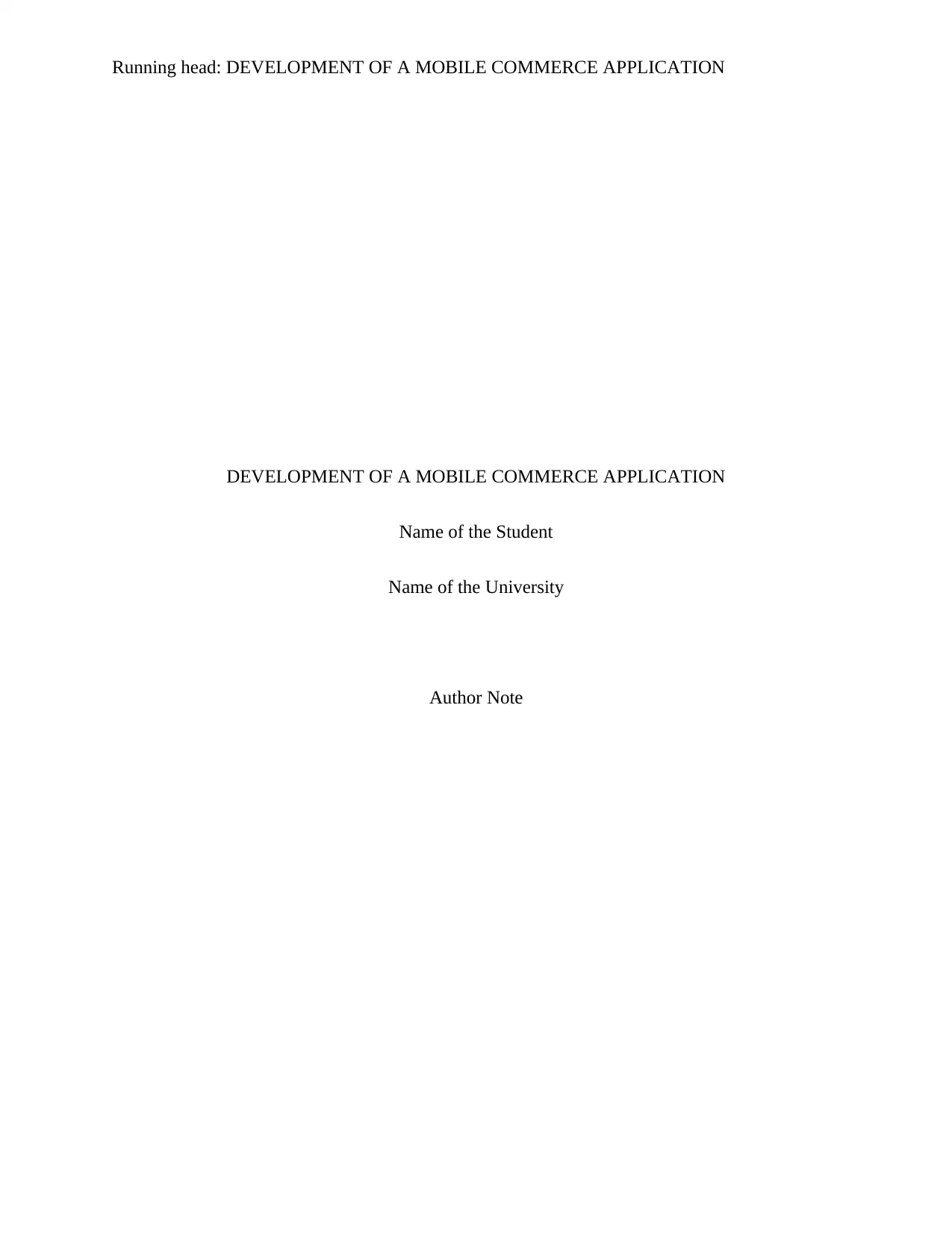
Running head: DEVELOPMENT OF A MOBILE COMMERCE APPLICATION
DEVELOPMENT OF A MOBILE COMMERCE APPLICATION
Name of the Student
Name of the University
Author Note
DEVELOPMENT OF A MOBILE COMMERCE APPLICATION
Name of the Student
Name of the University
Author Note
Paraphrase This Document
Need a fresh take? Get an instant paraphrase of this document with our AI Paraphraser
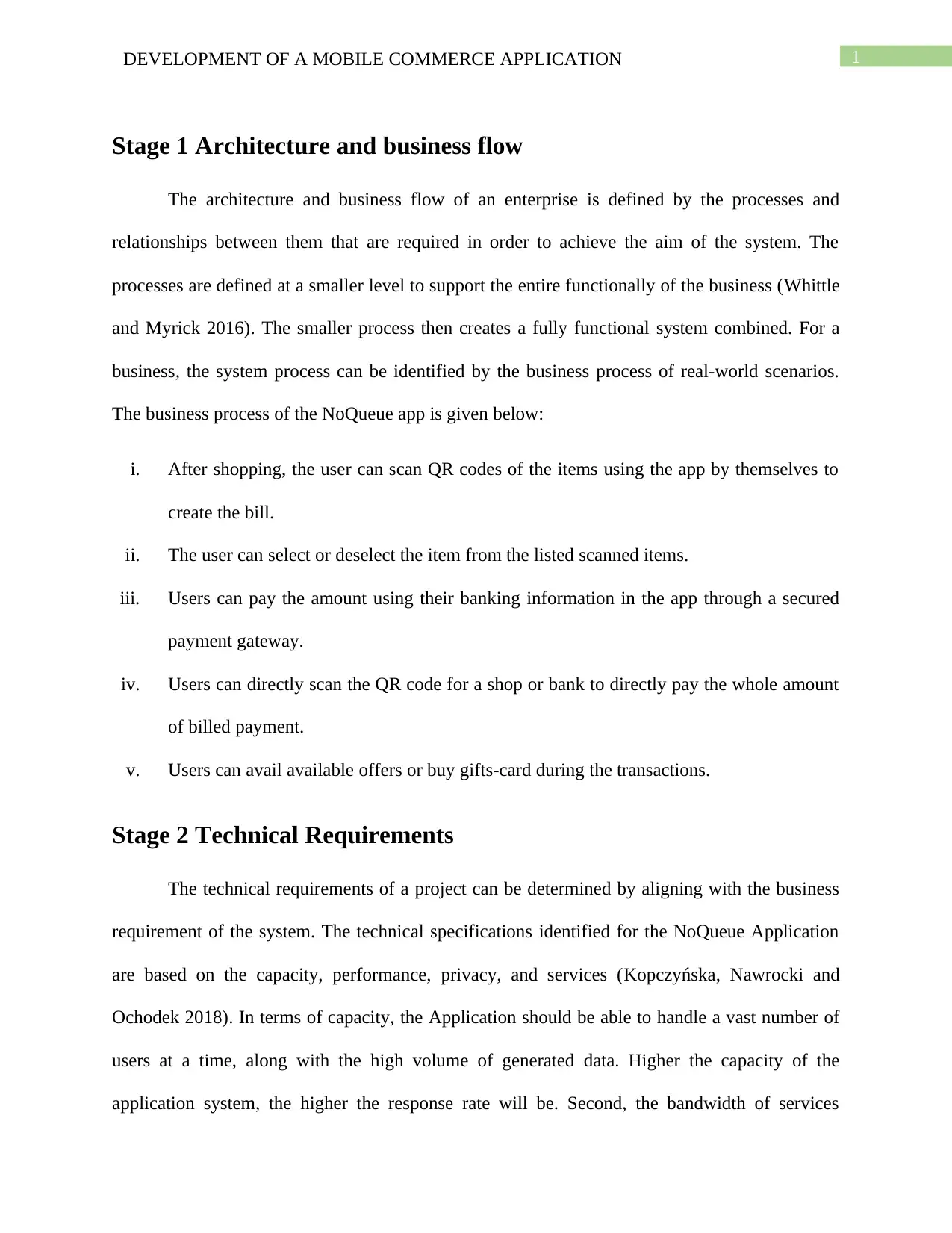
1DEVELOPMENT OF A MOBILE COMMERCE APPLICATION
Stage 1 Architecture and business flow
The architecture and business flow of an enterprise is defined by the processes and
relationships between them that are required in order to achieve the aim of the system. The
processes are defined at a smaller level to support the entire functionally of the business (Whittle
and Myrick 2016). The smaller process then creates a fully functional system combined. For a
business, the system process can be identified by the business process of real-world scenarios.
The business process of the NoQueue app is given below:
i. After shopping, the user can scan QR codes of the items using the app by themselves to
create the bill.
ii. The user can select or deselect the item from the listed scanned items.
iii. Users can pay the amount using their banking information in the app through a secured
payment gateway.
iv. Users can directly scan the QR code for a shop or bank to directly pay the whole amount
of billed payment.
v. Users can avail available offers or buy gifts-card during the transactions.
Stage 2 Technical Requirements
The technical requirements of a project can be determined by aligning with the business
requirement of the system. The technical specifications identified for the NoQueue Application
are based on the capacity, performance, privacy, and services (Kopczyńska, Nawrocki and
Ochodek 2018). In terms of capacity, the Application should be able to handle a vast number of
users at a time, along with the high volume of generated data. Higher the capacity of the
application system, the higher the response rate will be. Second, the bandwidth of services
Stage 1 Architecture and business flow
The architecture and business flow of an enterprise is defined by the processes and
relationships between them that are required in order to achieve the aim of the system. The
processes are defined at a smaller level to support the entire functionally of the business (Whittle
and Myrick 2016). The smaller process then creates a fully functional system combined. For a
business, the system process can be identified by the business process of real-world scenarios.
The business process of the NoQueue app is given below:
i. After shopping, the user can scan QR codes of the items using the app by themselves to
create the bill.
ii. The user can select or deselect the item from the listed scanned items.
iii. Users can pay the amount using their banking information in the app through a secured
payment gateway.
iv. Users can directly scan the QR code for a shop or bank to directly pay the whole amount
of billed payment.
v. Users can avail available offers or buy gifts-card during the transactions.
Stage 2 Technical Requirements
The technical requirements of a project can be determined by aligning with the business
requirement of the system. The technical specifications identified for the NoQueue Application
are based on the capacity, performance, privacy, and services (Kopczyńska, Nawrocki and
Ochodek 2018). In terms of capacity, the Application should be able to handle a vast number of
users at a time, along with the high volume of generated data. Higher the capacity of the
application system, the higher the response rate will be. Second, the bandwidth of services
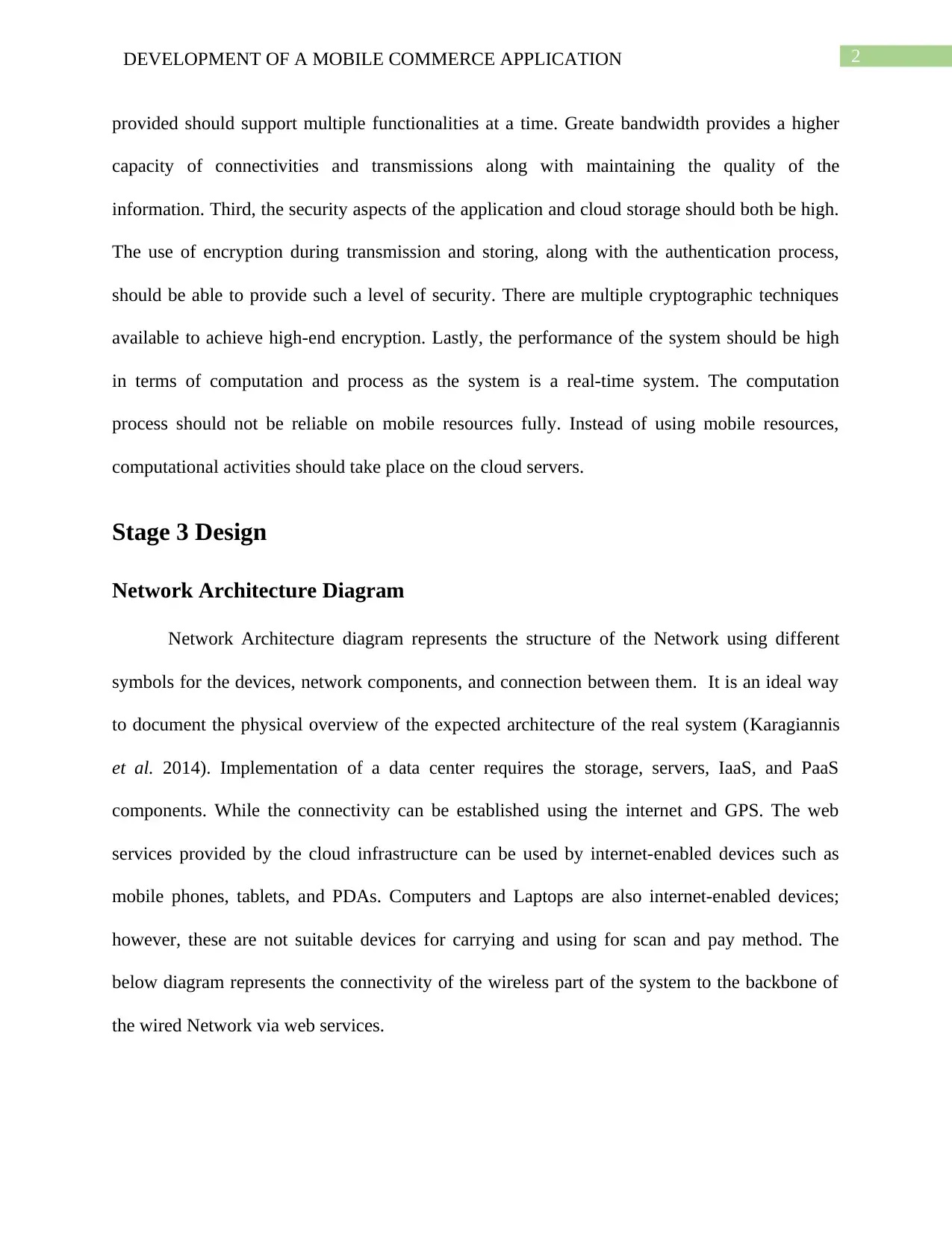
2DEVELOPMENT OF A MOBILE COMMERCE APPLICATION
provided should support multiple functionalities at a time. Greate bandwidth provides a higher
capacity of connectivities and transmissions along with maintaining the quality of the
information. Third, the security aspects of the application and cloud storage should both be high.
The use of encryption during transmission and storing, along with the authentication process,
should be able to provide such a level of security. There are multiple cryptographic techniques
available to achieve high-end encryption. Lastly, the performance of the system should be high
in terms of computation and process as the system is a real-time system. The computation
process should not be reliable on mobile resources fully. Instead of using mobile resources,
computational activities should take place on the cloud servers.
Stage 3 Design
Network Architecture Diagram
Network Architecture diagram represents the structure of the Network using different
symbols for the devices, network components, and connection between them. It is an ideal way
to document the physical overview of the expected architecture of the real system (Karagiannis
et al. 2014). Implementation of a data center requires the storage, servers, IaaS, and PaaS
components. While the connectivity can be established using the internet and GPS. The web
services provided by the cloud infrastructure can be used by internet-enabled devices such as
mobile phones, tablets, and PDAs. Computers and Laptops are also internet-enabled devices;
however, these are not suitable devices for carrying and using for scan and pay method. The
below diagram represents the connectivity of the wireless part of the system to the backbone of
the wired Network via web services.
provided should support multiple functionalities at a time. Greate bandwidth provides a higher
capacity of connectivities and transmissions along with maintaining the quality of the
information. Third, the security aspects of the application and cloud storage should both be high.
The use of encryption during transmission and storing, along with the authentication process,
should be able to provide such a level of security. There are multiple cryptographic techniques
available to achieve high-end encryption. Lastly, the performance of the system should be high
in terms of computation and process as the system is a real-time system. The computation
process should not be reliable on mobile resources fully. Instead of using mobile resources,
computational activities should take place on the cloud servers.
Stage 3 Design
Network Architecture Diagram
Network Architecture diagram represents the structure of the Network using different
symbols for the devices, network components, and connection between them. It is an ideal way
to document the physical overview of the expected architecture of the real system (Karagiannis
et al. 2014). Implementation of a data center requires the storage, servers, IaaS, and PaaS
components. While the connectivity can be established using the internet and GPS. The web
services provided by the cloud infrastructure can be used by internet-enabled devices such as
mobile phones, tablets, and PDAs. Computers and Laptops are also internet-enabled devices;
however, these are not suitable devices for carrying and using for scan and pay method. The
below diagram represents the connectivity of the wireless part of the system to the backbone of
the wired Network via web services.
⊘ This is a preview!⊘
Do you want full access?
Subscribe today to unlock all pages.

Trusted by 1+ million students worldwide
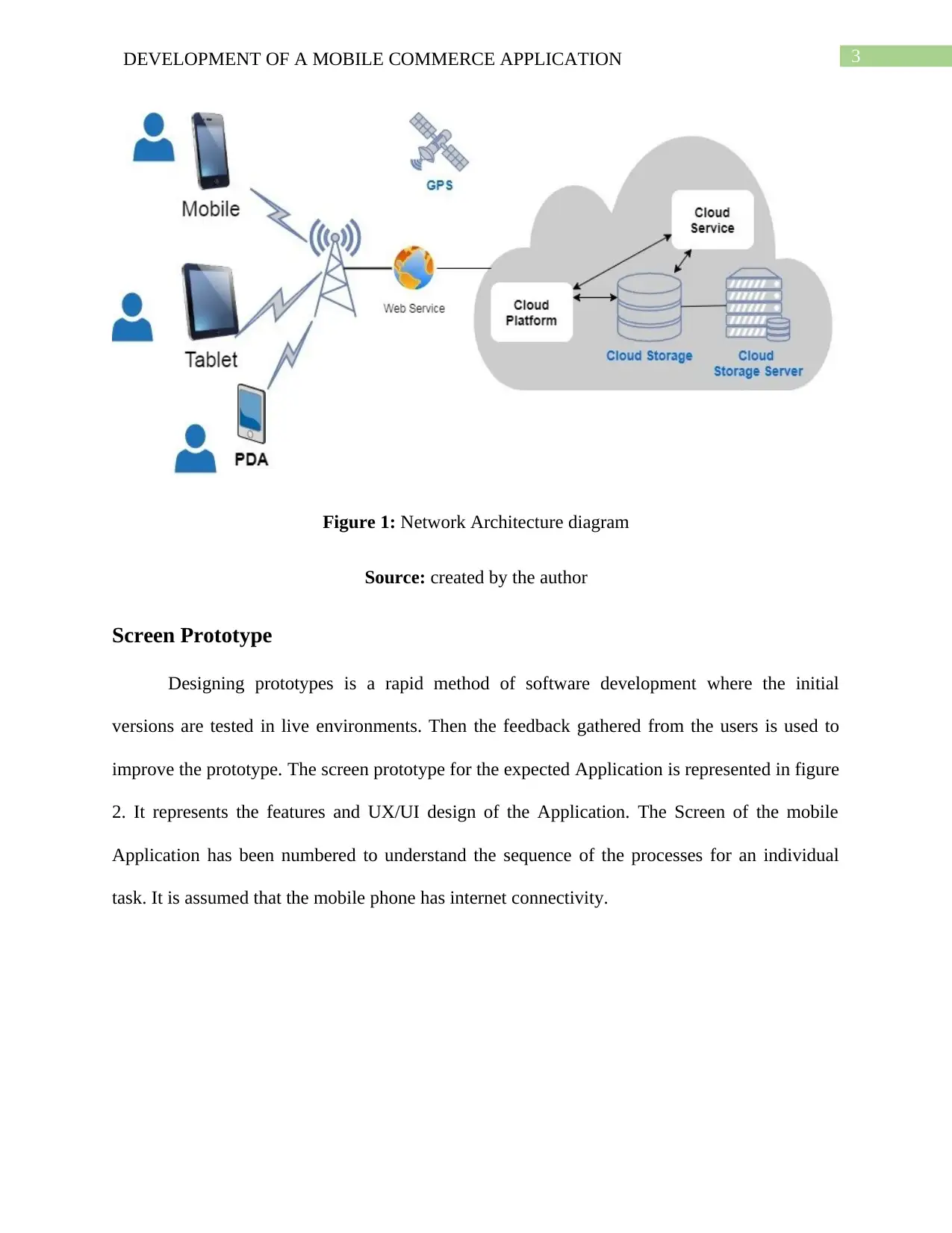
3DEVELOPMENT OF A MOBILE COMMERCE APPLICATION
Figure 1: Network Architecture diagram
Source: created by the author
Screen Prototype
Designing prototypes is a rapid method of software development where the initial
versions are tested in live environments. Then the feedback gathered from the users is used to
improve the prototype. The screen prototype for the expected Application is represented in figure
2. It represents the features and UX/UI design of the Application. The Screen of the mobile
Application has been numbered to understand the sequence of the processes for an individual
task. It is assumed that the mobile phone has internet connectivity.
Figure 1: Network Architecture diagram
Source: created by the author
Screen Prototype
Designing prototypes is a rapid method of software development where the initial
versions are tested in live environments. Then the feedback gathered from the users is used to
improve the prototype. The screen prototype for the expected Application is represented in figure
2. It represents the features and UX/UI design of the Application. The Screen of the mobile
Application has been numbered to understand the sequence of the processes for an individual
task. It is assumed that the mobile phone has internet connectivity.
Paraphrase This Document
Need a fresh take? Get an instant paraphrase of this document with our AI Paraphraser
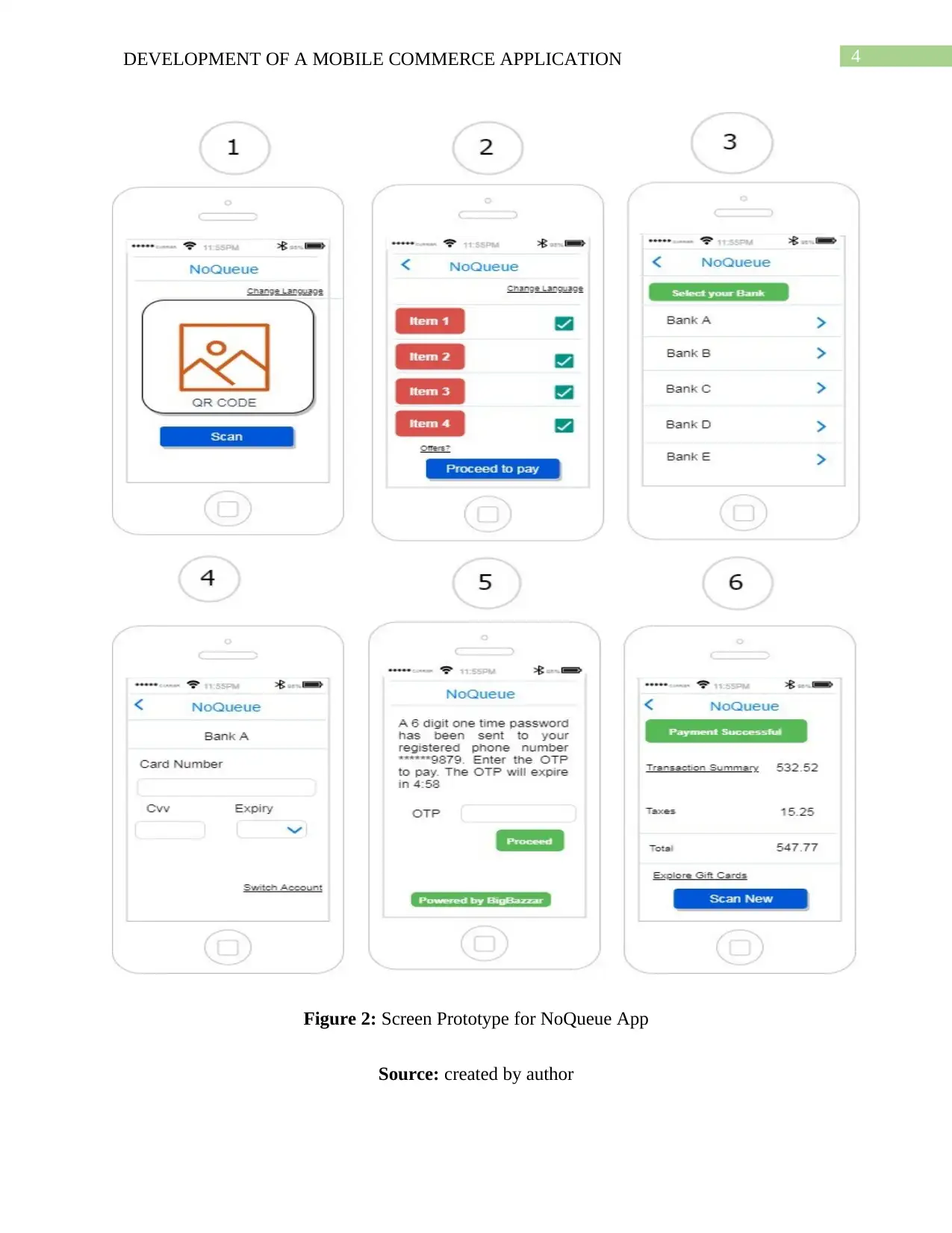
4DEVELOPMENT OF A MOBILE COMMERCE APPLICATION
Figure 2: Screen Prototype for NoQueue App
Source: created by author
Figure 2: Screen Prototype for NoQueue App
Source: created by author
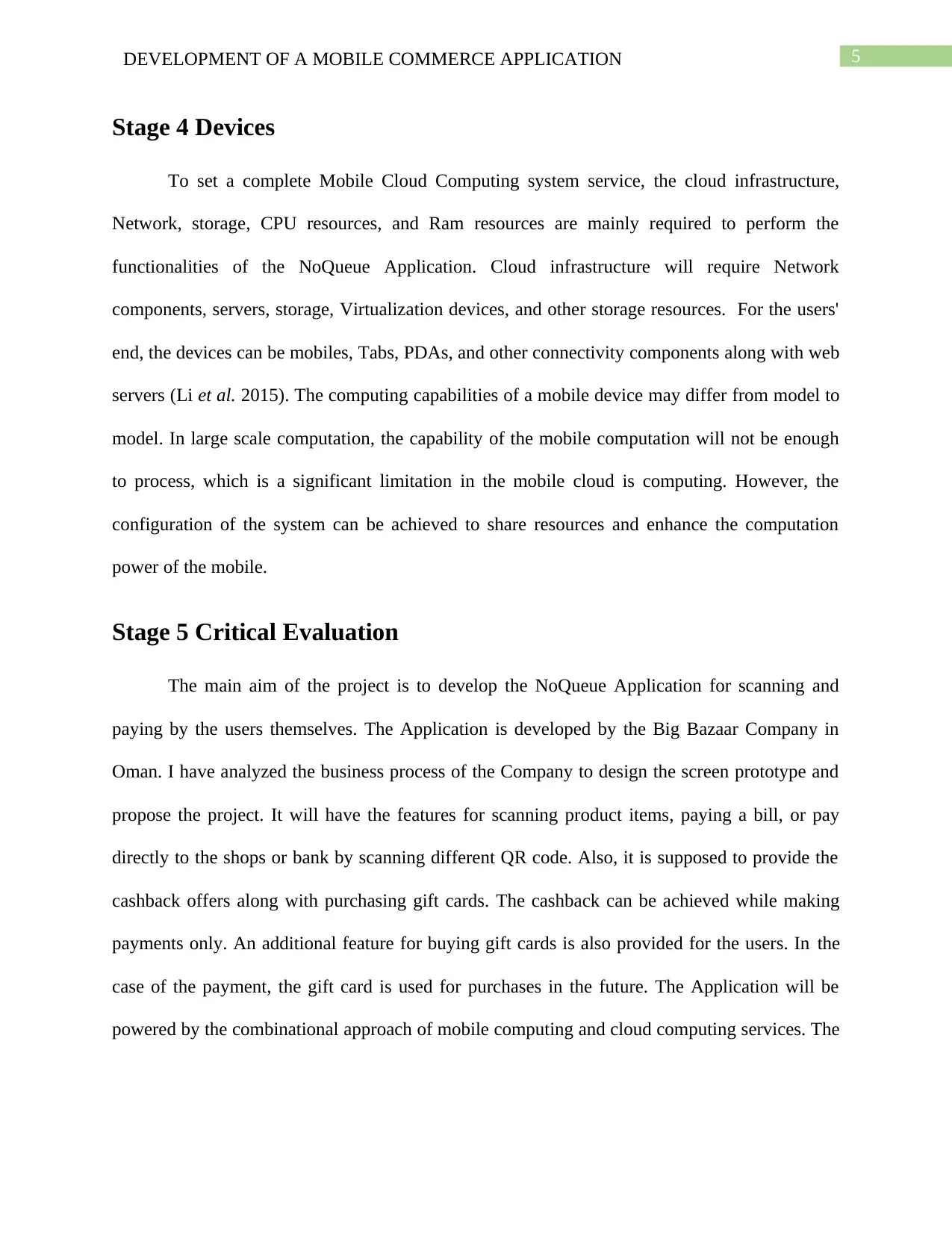
5DEVELOPMENT OF A MOBILE COMMERCE APPLICATION
Stage 4 Devices
To set a complete Mobile Cloud Computing system service, the cloud infrastructure,
Network, storage, CPU resources, and Ram resources are mainly required to perform the
functionalities of the NoQueue Application. Cloud infrastructure will require Network
components, servers, storage, Virtualization devices, and other storage resources. For the users'
end, the devices can be mobiles, Tabs, PDAs, and other connectivity components along with web
servers (Li et al. 2015). The computing capabilities of a mobile device may differ from model to
model. In large scale computation, the capability of the mobile computation will not be enough
to process, which is a significant limitation in the mobile cloud is computing. However, the
configuration of the system can be achieved to share resources and enhance the computation
power of the mobile.
Stage 5 Critical Evaluation
The main aim of the project is to develop the NoQueue Application for scanning and
paying by the users themselves. The Application is developed by the Big Bazaar Company in
Oman. I have analyzed the business process of the Company to design the screen prototype and
propose the project. It will have the features for scanning product items, paying a bill, or pay
directly to the shops or bank by scanning different QR code. Also, it is supposed to provide the
cashback offers along with purchasing gift cards. The cashback can be achieved while making
payments only. An additional feature for buying gift cards is also provided for the users. In the
case of the payment, the gift card is used for purchases in the future. The Application will be
powered by the combinational approach of mobile computing and cloud computing services. The
Stage 4 Devices
To set a complete Mobile Cloud Computing system service, the cloud infrastructure,
Network, storage, CPU resources, and Ram resources are mainly required to perform the
functionalities of the NoQueue Application. Cloud infrastructure will require Network
components, servers, storage, Virtualization devices, and other storage resources. For the users'
end, the devices can be mobiles, Tabs, PDAs, and other connectivity components along with web
servers (Li et al. 2015). The computing capabilities of a mobile device may differ from model to
model. In large scale computation, the capability of the mobile computation will not be enough
to process, which is a significant limitation in the mobile cloud is computing. However, the
configuration of the system can be achieved to share resources and enhance the computation
power of the mobile.
Stage 5 Critical Evaluation
The main aim of the project is to develop the NoQueue Application for scanning and
paying by the users themselves. The Application is developed by the Big Bazaar Company in
Oman. I have analyzed the business process of the Company to design the screen prototype and
propose the project. It will have the features for scanning product items, paying a bill, or pay
directly to the shops or bank by scanning different QR code. Also, it is supposed to provide the
cashback offers along with purchasing gift cards. The cashback can be achieved while making
payments only. An additional feature for buying gift cards is also provided for the users. In the
case of the payment, the gift card is used for purchases in the future. The Application will be
powered by the combinational approach of mobile computing and cloud computing services. The
⊘ This is a preview!⊘
Do you want full access?
Subscribe today to unlock all pages.

Trusted by 1+ million students worldwide
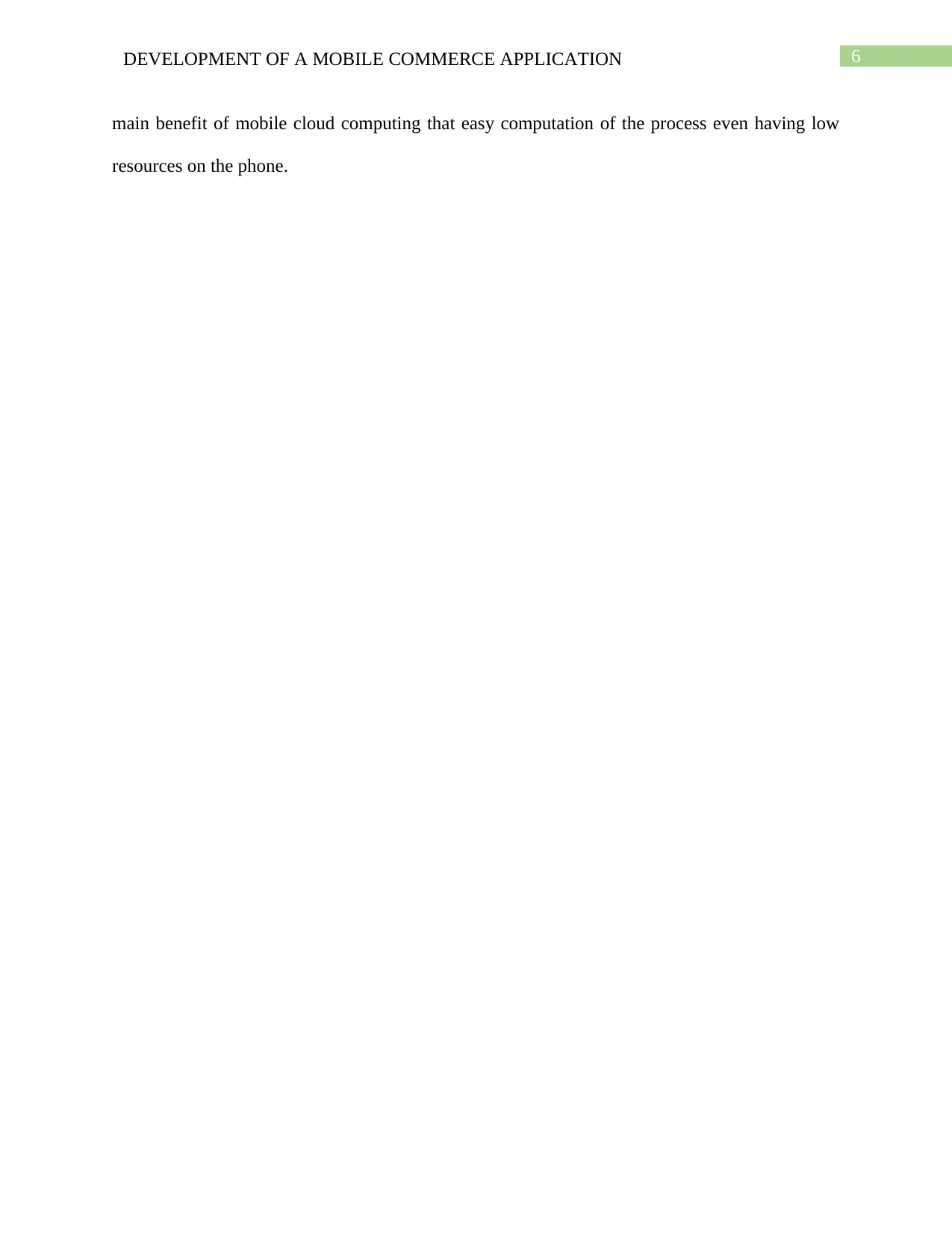
6DEVELOPMENT OF A MOBILE COMMERCE APPLICATION
main benefit of mobile cloud computing that easy computation of the process even having low
resources on the phone.
main benefit of mobile cloud computing that easy computation of the process even having low
resources on the phone.
Paraphrase This Document
Need a fresh take? Get an instant paraphrase of this document with our AI Paraphraser
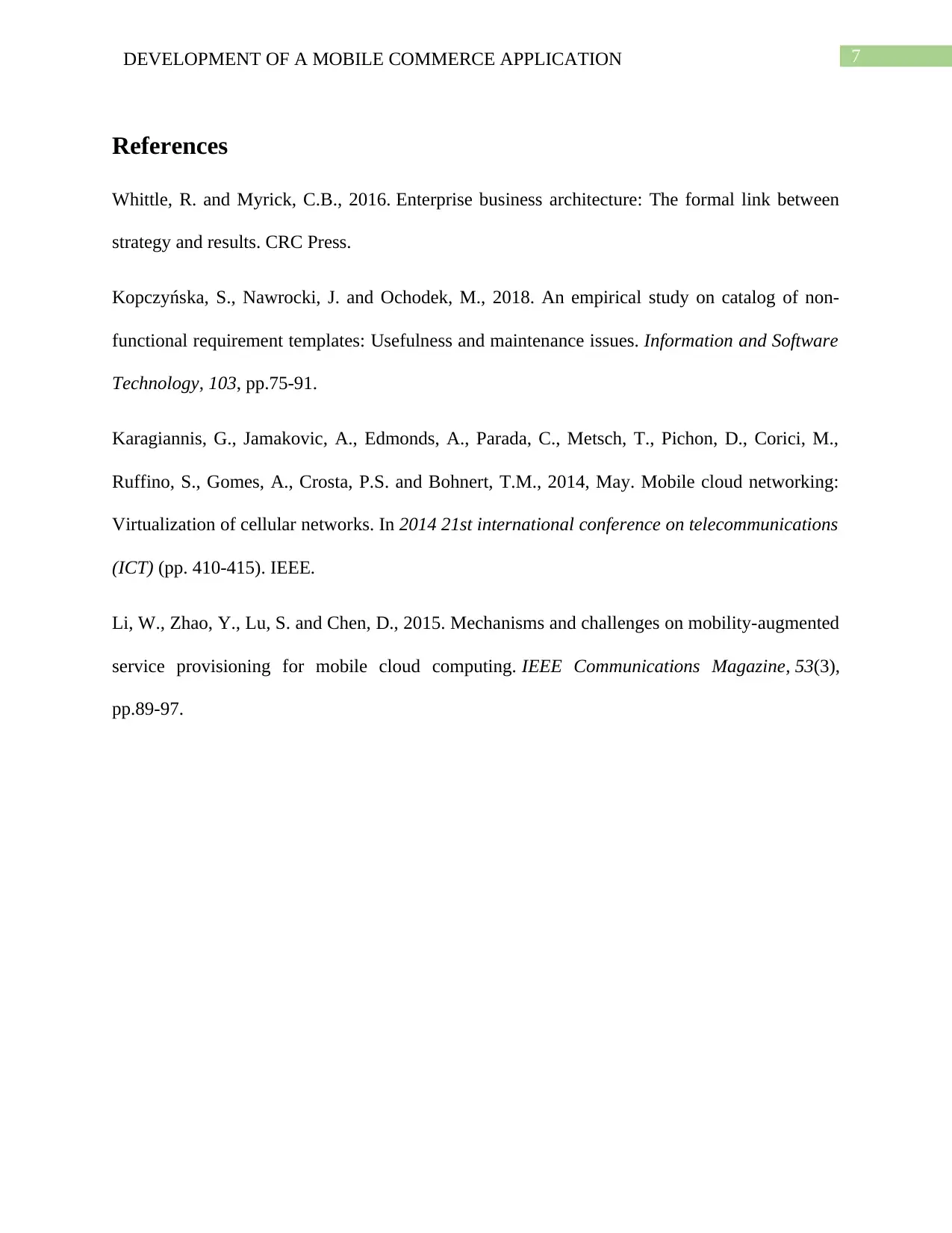
7DEVELOPMENT OF A MOBILE COMMERCE APPLICATION
References
Whittle, R. and Myrick, C.B., 2016. Enterprise business architecture: The formal link between
strategy and results. CRC Press.
Kopczyńska, S., Nawrocki, J. and Ochodek, M., 2018. An empirical study on catalog of non-
functional requirement templates: Usefulness and maintenance issues. Information and Software
Technology, 103, pp.75-91.
Karagiannis, G., Jamakovic, A., Edmonds, A., Parada, C., Metsch, T., Pichon, D., Corici, M.,
Ruffino, S., Gomes, A., Crosta, P.S. and Bohnert, T.M., 2014, May. Mobile cloud networking:
Virtualization of cellular networks. In 2014 21st international conference on telecommunications
(ICT) (pp. 410-415). IEEE.
Li, W., Zhao, Y., Lu, S. and Chen, D., 2015. Mechanisms and challenges on mobility-augmented
service provisioning for mobile cloud computing. IEEE Communications Magazine, 53(3),
pp.89-97.
References
Whittle, R. and Myrick, C.B., 2016. Enterprise business architecture: The formal link between
strategy and results. CRC Press.
Kopczyńska, S., Nawrocki, J. and Ochodek, M., 2018. An empirical study on catalog of non-
functional requirement templates: Usefulness and maintenance issues. Information and Software
Technology, 103, pp.75-91.
Karagiannis, G., Jamakovic, A., Edmonds, A., Parada, C., Metsch, T., Pichon, D., Corici, M.,
Ruffino, S., Gomes, A., Crosta, P.S. and Bohnert, T.M., 2014, May. Mobile cloud networking:
Virtualization of cellular networks. In 2014 21st international conference on telecommunications
(ICT) (pp. 410-415). IEEE.
Li, W., Zhao, Y., Lu, S. and Chen, D., 2015. Mechanisms and challenges on mobility-augmented
service provisioning for mobile cloud computing. IEEE Communications Magazine, 53(3),
pp.89-97.
1 out of 8
Related Documents
Your All-in-One AI-Powered Toolkit for Academic Success.
+13062052269
info@desklib.com
Available 24*7 on WhatsApp / Email
![[object Object]](/_next/static/media/star-bottom.7253800d.svg)
Unlock your academic potential
Copyright © 2020–2025 A2Z Services. All Rights Reserved. Developed and managed by ZUCOL.





